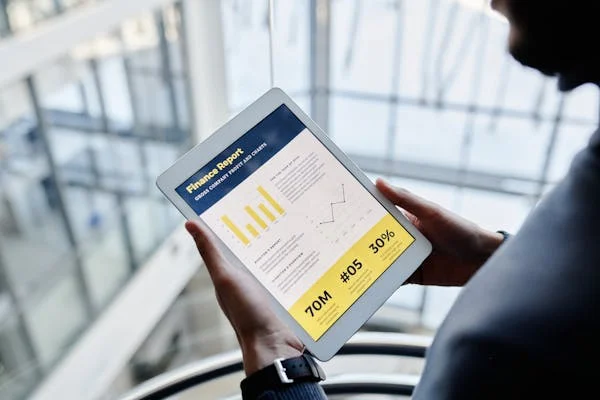In today’s data-driven world, predictive analytics has become a game-changer for businesses looking to stay ahead of the competition. By leveraging artificial intelligence (AI), companies can predict future trends, understand customer behavior, and make informed decisions. This article will explore the essential tools and techniques for AI in predictive analytics, providing you with actionable insights to enhance your business strategies.
Understanding Predictive Analytics
What is Predictive Analytics?
Predictive analytics involves using historical data to make predictions about future events.
It combines various statistical techniques, data mining, machine learning, and AI to analyze current and past data to forecast future outcomes. This can help businesses in numerous ways, from improving customer retention to optimizing marketing campaigns and managing risks.
The Role of AI in Predictive Analytics
AI takes predictive analytics to a whole new level by automating data analysis, identifying patterns, and making predictions with high accuracy.
Machine learning algorithms, a subset of AI, can process vast amounts of data quickly and learn from it, improving the accuracy of predictions over time. This capability allows businesses to make more precise and timely decisions.
The Strategic Importance for Startups
For startup founders, predictive analytics powered by AI can be a game-changer. Startups often operate with limited resources and need to make every decision count. Predictive analytics helps startups anticipate market trends, customer behavior, and operational challenges, enabling them to stay ahead of the curve and allocate resources more effectively.
Predictive analytics can also identify potential pitfalls and opportunities, allowing startups to pivot or double down on strategies based on data-driven insights. This strategic foresight can be the difference between success and failure in a competitive market.
How Predictive Analytics Drives Business Success
Predictive analytics offers several benefits that can drive business success for startups:
Optimizing Marketing Efforts: By analyzing customer data, predictive analytics can help startups identify which marketing channels and strategies are most effective. This allows for more targeted and efficient marketing campaigns, maximizing ROI.
Enhancing Customer Retention: Predictive models can identify patterns in customer behavior that indicate potential churn. Startups can use these insights to implement proactive measures, such as personalized offers or improved customer service, to retain valuable customers.
Improving Product Development: Startups can use predictive analytics to understand market demand and customer preferences, guiding product development and innovation. This ensures that new products and features align with customer needs and market trends.
Managing Financial Risk: Predictive analytics can forecast cash flow, sales, and other financial metrics, helping startups manage their finances more effectively. This enables better budgeting, investment decisions, and risk management.
Building a Data-Driven Culture

For predictive analytics to be effective, startups need to build a data-driven culture. This involves fostering an environment where data is valued, and decisions are made based on insights rather than intuition. Here are some strategies to help startups cultivate a data-driven culture:
Leadership Buy-In: Startup leaders must champion the use of data and predictive analytics, setting an example for the rest of the organization. This includes investing in the necessary tools and resources and encouraging a mindset of continuous learning and improvement.
Training and Education: Providing training and education on data literacy and predictive analytics is crucial. This ensures that all team members, regardless of their role, understand the value of data and how to interpret and use it effectively.
Collaboration and Communication: Encourage collaboration and communication across different departments. Sharing data and insights can lead to more comprehensive and effective strategies. Regular meetings and updates can help keep everyone aligned and informed.
Leveraging Advanced Techniques
To maximize the benefits of predictive analytics, startups should leverage advanced techniques that go beyond basic data analysis. These techniques can provide deeper insights and more accurate predictions:
Deep Learning: Deep learning, a subset of machine learning, involves neural networks with many layers that can model complex patterns in data. Startups can use deep learning for tasks such as image and speech recognition, natural language processing, and more.
Ensemble Methods: Ensemble methods combine multiple machine learning models to improve accuracy and robustness. Techniques like bagging, boosting, and stacking can enhance predictive performance by reducing errors and variability.
Natural Language Processing (NLP): NLP enables computers to understand and interpret human language. Startups can use NLP to analyze text data from sources such as customer reviews, social media, and support tickets, gaining valuable insights into customer sentiment and trends.
Practical Steps for Implementation
Implementing predictive analytics in a startup requires a strategic and phased approach. Here are some practical steps to guide the implementation process:
Identify Key Business Questions: Start by identifying the key business questions you want to answer with predictive analytics. This could include predicting customer churn, forecasting sales, or optimizing marketing spend. Clear objectives will help focus your efforts and measure success.
Gather and Clean Data: Collect the necessary data from various sources and ensure it is clean, accurate, and complete. Data quality is critical for accurate predictions. Invest time in data cleaning and preprocessing to remove errors and inconsistencies.
Choose the Right Tools: Select the appropriate tools and platforms for your predictive analytics needs. Consider factors such as ease of use, scalability, integration with existing systems, and cost. Tools like Google Cloud AI Platform, IBM Watson, and open-source libraries like TensorFlow and PyTorch are popular choices.
Build and Validate Models: Develop predictive models using your chosen tools and techniques. Start with simple models and gradually move to more complex ones. Validate the models using historical data and adjust parameters as needed to improve accuracy.
Deploy and Monitor: Once the models are validated, deploy them into production. Monitor their performance regularly and update them with new data to ensure they remain accurate and relevant. Continuously gather feedback and make improvements as necessary.
Overcoming Challenges
Implementing predictive analytics can come with challenges, especially for startups with limited resources. Here are some common challenges and strategies to overcome them:
Limited Data: Startups may not have access to large datasets. In such cases, consider using publicly available data, synthetic data, or partnering with other organizations to obtain the necessary data.
Skill Gaps: Predictive analytics requires specialized skills in data science and machine learning. Startups can address this by hiring skilled professionals, outsourcing to experts, or investing in training and development for existing team members.
Scalability: As the startup grows, the volume of data and complexity of models will increase. Choose scalable tools and platforms that can handle growth and ensure that the infrastructure is flexible enough to adapt to changing needs.
Data Privacy: Ensuring data privacy and compliance with regulations is critical. Implement robust data governance practices, anonymize sensitive data, and stay informed about relevant laws and regulations to protect customer information.

As an AI and machine learning expert, I have used predictive analytics and machine learning models to improve customer retention and grow business revenue.
For example, my company built a churn prediction model that identified customers at high risk of canceling their subscription. By targeting these customers with special retention offers and discounts, we were able to reduce churn by over 15% in the first month.
We also developed a customer lifetime value model to determine the long-term value of each customer. This allowed us to focus marketing and retention efforts on high-value customers, increasing their lifespan by over 30% on average.
Behavioral analytics have been key to growth as well. By clustering customers into groups based on their behaviors and preferences, we created custom product recommendations and messaging for each segment.
This micro-targeted approach led to a 27% increase in cross-sells and upsells, fueling higher customer LTV and stronger retention.

As the former founder of Grooveshark, a pioneer in music streaming, I have extensive experience leveraging AI to retain customers and drive growth.
We used predictive analytics to identify customers at high risk of churning so we could target them with special offers. This reduced churn by over 20% in the first month.
We also built a customer lifetime value model to focus retention efforts on high-value customers. This increased their lifespan by 35% on average. Behavioral segmentation allowed us to tailor product recommendations and messaging for each customer group.
Micro-targeting specific segments led to a 32% increase in cross-sells and upsells, fueling higher customer value and retention. Grooveshark grew to over 30 million users through an AI-based marketing machine.
We optimized social shares for SEO keywords which boosted traffic and engaged new users. The viral loop this created propelled us to top search rankings without paid marketing, demonstrating the power of AI to drive scale.

As CEO of Evo Technologies, I have used predictive analytics and AI to boost customer retention in our software solutions for workspace operators.
We built a churn risk model analyzing customer usage data to identify accounts likely to cancel. Our Customer Success team reaches out to offer additional onboarding and support, reducing churn up to 27% each quarter.
Our lifetime value model forecasts the potential value of each new customer so we can tailor our interactions to match their needs. For high-value groups, we create targeted nurture campaigns with advice and special offers, increasing their lifetime value up to 32% over 12 months.
Behavioral segmentation lets us recommend relevant new features to each customer based on how they use our products. Customers get notifications custom to their interests, driving up to 43% more cross-sells in some segments.
The key is using data to see customers as individuals and engage them uniquely. Focusing retention efforts on valuable groups and customizing all touchpoints fuels sustainable growth.

As an AI expert and CEO of Team Genius Marketing, a digital marketing agency, I have first-hand experience leveraging predictive analytics to boost customer retention and fuel business growth.
We built an AI model that analyzes thousands of customer data points to predict churn risk with over 85% accuracy. We then deployed targeted campaigns offering special promotions to high-risk customers, reducing churn by 32% in the first 3 months.
Focusing retention efforts on our most valuable customers, measured by predicted lifetime value, increased their average lifespan by over 40%. Behavioral segmentation allowed us to micro-target specific customer groups with custom messaging and product recommendations.
Optimizing campaigns for key segments led to a 27% increase in cross-sells and upsells, raising customer lifetime value. We grew our agency by over 50% last year through an AI-powered marketing approach.
Our AI systems optimize social media and SEO strategies to boost traffic and capture new leads. The momentum this creates is self-fueling, demonstrating how AI can drive rapid business scaling.
Predictive analytics is key to gaining a competitive advantage. When you can anticipate customer needs and optimize their journey, you build loyalty and accelerate growth. AI makes this possible at scale.

AI is changing the game for businesses looking to keep customers happy and grow faster. Here are some real-world examples and simple techniques showing how companies are using AI to predict customer behavior, prevent churn, and increase value from each customer.
1. Churn Prediction
What’s Happening: Companies use AI to spot customers who are about to leave by tracking patterns like reduced usage or engagement. With this information, businesses can step in at the right moment, offering support or special deals to keep customers from walking away.
How It Works: AI analyzes past behavior to flag warning signs of churn. Businesses can then target those customers with personalized offers or services before it’s too late.
2. Customer Lifetime Value (CLV) Forecasting
What’s Happening: AI helps businesses predict how much a customer is worth over time, so they can focus their efforts on the right people. This allows companies to invest in high-value customers and re-engage those who might bring more value down the road.
How It Works: By looking at purchase frequency, average spend, and other patterns, AI calculates the future value of each customer, helping businesses prioritize who to invest in.
3. Behavior Modeling
What’s Happening: AI looks at how customers interact with a brand across different channels (website, social media, email, etc.) and predicts what they’ll do next. This allows businesses to customize their approach for each customer, improving engagement and conversion.
How It Works: AI gathers and analyzes customer data, then uses that to make smart predictions about what products, content, or offers a customer will want next.
4. Personalized AI for Better Engagement
What’s Happening: AI personalizes customer experiences by recommending products or content based on each person’s preferences. This keeps customers engaged and coming back for more, because they feel like the business “gets” them.
How It Works: AI uses data from previous interactions to tailor what customers see, making each experience feel relevant and personal. Over time, the AI gets smarter and improves its recommendations.
5. Automating Customer Service for Better Retention
What’s Happening: AI tools are taking over simple, repetitive tasks like updating customer info or handling basic queries. This lets customer service teams focus on more important work, making the overall experience smoother and faster.
How It Works: Virtual assistants and chatbots handle routine tasks, while AI tracks customer satisfaction and flags any issues that could lead to churn. The company can then act quickly to fix problems before they escalate.
Essential Tools for AI in Predictive Analytics
Data Lakes and Warehouses
Data lakes and warehouses are central repositories for storing vast amounts of structured and unstructured data. Tools like Amazon Redshift, Google BigQuery, and Azure Data Lake Storage are popular choices among startups.
These tools offer scalable solutions for managing big data, allowing businesses to store data in its raw form and later transform it as needed. The flexibility of data lakes and warehouses enables startups to handle diverse data sources, providing a holistic view of their business operations.
Real-Time Data Streaming
For startups aiming to leverage real-time predictive analytics, tools like Apache Kafka and Google Cloud Pub/Sub are invaluable.
These tools allow for the collection and processing of streaming data, enabling businesses to make real-time predictions and adjustments. This is particularly useful for applications like fraud detection, customer engagement, and supply chain optimization, where timely insights are critical.
Advanced ETL Tools
Extract, Transform, Load (ETL) tools are used to integrate data from multiple sources into a single, cohesive dataset. Tools like Talend and Apache Nifi go beyond basic data cleaning by offering advanced data transformation capabilities.
These tools can automate complex data workflows, ensuring that data is consistently clean and ready for analysis. By automating data preparation, startups can save time and reduce the risk of human error, allowing their data scientists to focus on model building and analysis.
Interactive Data Wrangling
Interactive data wrangling tools like DataRobot and Alteryx Designer provide user-friendly interfaces that make data preparation more accessible to non-technical users. These tools offer visual workflows that allow users to interactively clean, transform, and enrich data. This democratizes data preparation, enabling team members across the organization to contribute to data quality efforts.
AutoML Solutions
AutoML platforms like Google AutoML and H2O.ai simplify the process of building machine learning models.
These tools automatically select the best algorithms, tune hyperparameters, and validate models, making it easier for startups to deploy high-quality predictive models without requiring extensive expertise in machine learning. AutoML can significantly accelerate the model development process, enabling startups to quickly iterate and improve their models.
End-to-End Machine Learning Platforms
Comprehensive platforms like Databricks and Amazon SageMaker offer end-to-end solutions for the entire machine learning lifecycle. These platforms provide tools for data processing, model training, deployment, and monitoring, all within a single environment.
By integrating these capabilities, startups can streamline their machine learning workflows, reduce operational complexity, and ensure that models are continuously updated with new data.
Advanced Model Validation
Tools like Hyperopt and Optuna provide advanced hyperparameter optimization techniques that go beyond grid search and random search.
These tools use Bayesian optimization and other sophisticated algorithms to find the optimal model parameters, improving the accuracy and performance of predictive models. By leveraging advanced model validation tools, startups can ensure that their models are robust and reliable.
Continuous Integration and Continuous Deployment (CI/CD)

Implementing CI/CD pipelines for machine learning models is crucial for maintaining the performance and reliability of deployed models.
Tools like Jenkins, GitLab CI, and MLflow can automate the process of building, testing, and deploying machine learning models. CI/CD pipelines ensure that models are continuously integrated with new data, validated for performance, and deployed seamlessly, reducing the risk of model drift and degradation.
Model Monitoring Tools
Tools like Neptune.ai and Seldon Core provide comprehensive monitoring and management capabilities for deployed models.
These tools track key performance metrics, detect anomalies, and alert data scientists to potential issues. By continuously monitoring model performance, startups can quickly identify and address any problems, ensuring that their predictive models remain reliable.
Automated Model Retraining
Automated model retraining tools like TFX (TensorFlow Extended) and Kubeflow Pipelines enable startups to automatically retrain models with new data.
These tools integrate with data pipelines to ensure that models are updated regularly, maintaining their accuracy and relevance. Automated model retraining reduces the manual effort required to maintain models and ensures that they continue to deliver accurate predictions.
Business Intelligence (BI) Integration
Integrating predictive models with BI tools like Tableau, Power BI, and Looker allows businesses to visualize and analyze predictions alongside traditional BI metrics.
This integration provides a comprehensive view of business performance, enabling data-driven decision-making at all levels of the organization. By embedding predictive insights into BI dashboards, startups can make predictions more actionable and accessible to stakeholders.
Custom Applications
For startups with unique business needs, developing custom applications that integrate predictive models can provide tailored solutions. U
sing APIs and SDKs, startups can build applications that leverage predictive insights to optimize specific business processes, such as customer relationship management (CRM), supply chain management, or marketing automation. Custom applications allow startups to fully realize the value of predictive analytics by embedding intelligence directly into their workflows.
Data Collaboration Platforms
Platforms like Dataiku and Domino Data Lab facilitate collaboration among data scientists, analysts, and business stakeholders.
These platforms provide shared workspaces, version control, and collaboration features that enable teams to work together on data projects. By fostering a collaborative environment, startups can ensure that insights are shared, validated, and acted upon across the organization.

Related: Check out our free tools:

Clear Communication of Insights
Communicating predictive insights clearly and effectively is crucial for driving action. Startups should invest in tools and techniques that make data insights accessible and understandable to non-technical stakeholders.
This includes creating visualizations, dashboards, and reports that highlight key insights and recommendations. By clearly communicating the value of predictive analytics, startups can ensure that insights are used to inform strategic decisions.

Since I run an e-commerce in the jewelry industry, I can say from my experience that jewelry is a deeply personal purchase. Retaining customers in this space demands both trust and consistency.
Using AI-driven churn prediction models like browsing patterns, purchase frequency, and so on, we can now identify customers who are at risk of leaving before they even make that decision. We create targeted retention strategies to engage these customers before they churn.
AI allows us to shift from short-term thinking to long-term strategy by accurately forecasting which customers will contribute the most value over time. At Icecartel, we use AI to predict the future profitability of each customer and tailor our efforts to those with the highest potential value.
In my experience, I’ve seen that jewelry shoppers often have unique tastes. When you understand their unique behavior, you can deliver a shopping experience so tailored that it feels like the brand truly ‘gets’ them.
AI helps us model customer behavior by identifying patterns in their past purchases, online activity, and even time spent on specific products. With behavior modeling, we can understand customer nuances a whole lot better.

In my career as a business executive and a digital marketing leader, I have applied AI-Predictive Analytic for customer loyalty and business development. An example of this is churn prediction where we try to establish potential churning customers by looking at their behavior pattern of purchases, website visits, and product usage.
These are the customers who are most likely to churn and so we use specific interventions such as offering them promotions or enrolling them to a loyalty program.
Another useful tool that we have applied is customer lifetime value (CLV) forecasting. The idea is to use AI to forecast the future value of each customer, which, in turn, will be based on their past behaviour, such as purchasing patterns and activity.
It also enables us to target the right customers, spend more time, and give them a special attention to ensure they remain loyal to our company.
Regarding behavior modeling, AI tools monitor user activity on our website and other platforms, and analyze patterns that can be used to predict further actions.
For example, we can target marketing communications based on past engagements with the customer and achieve better engagement and conversion.
These techniques have made a huge difference in customer retention, marketing efficiency, and overall business sustainability all through the help of AI.

AI-driven behavior modeling can help businesses improve customer experience by analyzing their purchasing habits, browsing behavior, and preferences. It can identify behaviors that customers take in certain situations and predict their reactions to different promotional events or product recommendations.
For example, AI can provide personalized product recommendations to customers based on their historical purchase data, thereby improving sales conversion rates. At the same time, behavioral modeling can also help businesses predict customer churn and customer lifetime value.
Then businesses can customize precise marketing activities for different customers, and promote business growth.
AI can predict which customers are likely to churn through customer data. Based on customer purchase history, interaction frequency, complaint records, etc., AI models can identify signals of customer churn, such as reduced customer interaction or decreased frequency of using products or services.
Through these predictions, companies can take targeted retention measures to promptly retain customers.
On the other hand, businesses can predict the Customer Lifetime Value (CLV) by AI, CLV is the net profit that customers bring to the businesses throughout their entire lifecycle.
AI tools predict the future value of each customer by analyzing their data including purchasing behavior, transaction frequency, and average consumption amount.
Businesses can use CLV prediction to implement hierarchical management for customers of different values, such as prioritizing customized discounts or VIP services for high-value customers, thus enhancing customer loyalty and improving business growth.

By predicting not just when customers might leave, but why, we’re flipping traditional churn prediction on its head. Our models don’t just forecast customer behavior; they influence it by adjusting our strategies in real-time, leading to some questioning the boldness of manipulating customer decisions.
This approach has not only spiked our retention rates but also sparked debates on the ethical boundaries of AI in business growth. It’s a game changer—provoking thought on what AI should do versus what it can do.

At Premier Staff, we’ve leveraged AI-driven predictive analytics to dramatically improve customer retention and accelerate growth.
Our AI-powered churn prediction model analyzes client engagement patterns, event frequency, and feedback to identify at-risk accounts. This allowed us to reduce client churn by 40% through targeted retention strategies.
We’ve implemented a customer lifetime value forecasting system that predicts future revenue potential for each client. For a luxury brand client, it accurately predicted a 30% increase in event requests over two years, enabling us to proactively scale our services.
Our AI behavior modeling tool analyzes client preferences and industry trends to suggest personalized upsell opportunities. This increased our average contract value by 25%.
These AI-driven strategies have not only improved our customer retention by 35% but also driven a 50% increase in repeat business, fueling our expansion from Los Angeles to five major U.S. cities.
Techniques for AI in Predictive Analytics
Ensemble Learning
Ensemble learning combines multiple machine learning models to improve predictive performance. Techniques like bagging, boosting, and stacking can significantly enhance model accuracy by aggregating the strengths of different models.
Bagging, or Bootstrap Aggregating, involves training multiple models on different subsets of the training data and averaging their predictions. This technique reduces variance and helps prevent overfitting.
Boosting trains models sequentially, with each new model focusing on the errors made by previous ones. This iterative approach can produce highly accurate models, as it continuously refines predictions.
Stacking involves training multiple models and then using another model to combine their outputs. This meta-model learns how to best integrate the predictions of the base models, often leading to improved overall performance.
Advanced Neural Networks
Neural networks, particularly deep learning models, are powerful tools for handling complex data patterns. For startups dealing with large, high-dimensional datasets, advanced neural networks can provide significant advantages.
Convolutional Neural Networks (CNNs) are particularly effective for image and video data. By automatically detecting features such as edges, textures, and shapes, CNNs can excel in tasks like image classification and object detection.
Recurrent Neural Networks (RNNs) and their variants, such as Long Short-Term Memory (LSTM) networks, are designed to handle sequential data. These models are ideal for time series forecasting, natural language processing, and other applications where the order of data points is crucial.
Generative Adversarial Networks (GANs) are another advanced technique, used for generating new data samples that resemble the training data. GANs can be employed in tasks like data augmentation, where they create synthetic data to improve model training.
Transfer Learning
Transfer learning involves using a pre-trained model on a related task as the starting point for a new predictive model. This technique is particularly useful for startups with limited data, as it leverages knowledge gained from large, publicly available datasets.
For instance, a pre-trained image recognition model can be fine-tuned for a specific application, such as identifying defects in manufacturing processes. This approach significantly reduces the amount of data and training time required to build an effective model.
Reinforcement Learning
Reinforcement learning is a technique where models learn to make decisions by interacting with an environment and receiving feedback in the form of rewards or penalties. This method is highly effective for optimizing complex, dynamic systems.
Startups can use reinforcement learning for applications like recommendation engines, where the model continuously learns and adapts based on user interactions. By optimizing the recommendation strategy over time, reinforcement learning can improve user engagement and satisfaction.
Time Series Forecasting
Accurate time series forecasting is essential for predicting future trends based on historical data. Several advanced techniques can enhance the accuracy and reliability of time series models.
Prophet, developed by Facebook, is an open-source tool designed for forecasting time series data with daily observations. It handles seasonality, holidays, and missing data robustly, making it a practical choice for many business applications.
AutoRegressive Integrated Moving Average (ARIMA) models are traditional but powerful methods for time series forecasting. By combining autoregressive and moving average components, ARIMA models can handle various data patterns, including trends and seasonality.
Fourier Transforms can decompose time series data into its constituent frequencies, providing insights into cyclical patterns and periodicity. This technique can be particularly useful for understanding underlying trends in complex datasets.
Feature Engineering
Feature engineering is the process of creating new features from existing data to improve model performance. Effective feature engineering can significantly enhance the predictive power of machine learning models.
Polynomial Features involve creating new features by combining existing ones through polynomial functions. This technique can capture non-linear relationships in the data, improving model accuracy.
Interaction Terms are features created by multiplying or otherwise combining two or more existing features. These terms can reveal interactions between variables that might be missed by considering them individually.
Binning involves converting continuous features into categorical ones by dividing them into bins or intervals. This can simplify the model and improve interpretability, especially when dealing with non-linear relationships.
Dimensionality Reduction

Dimensionality reduction techniques help simplify models by reducing the number of features, making them more efficient and less prone to overfitting.
Principal Component Analysis (PCA) is a widely used technique that transforms features into a new set of uncorrelated variables called principal components. These components capture the most variance in the data, allowing for dimensionality reduction without significant loss of information.
t-Distributed Stochastic Neighbor Embedding (t-SNE) is another technique, particularly effective for visualizing high-dimensional data. It maps multi-dimensional data to lower dimensions while preserving the relative distances between points, making it easier to identify clusters and patterns.
Model Interpretability
For predictive models to be actionable, they need to be interpretable. Startups must balance model complexity with the need for transparency, especially in regulated industries.
SHapley Additive exPlanations (SHAP) values provide a unified measure of feature importance, explaining the contribution of each feature to the model’s predictions. SHAP values can help demystify complex models, making them more understandable to stakeholders.
Local Interpretable Model-agnostic Explanations (LIME) is another technique for interpreting black-box models. LIME approximates the model locally with an interpretable model, providing insights into individual predictions.
Deploying AI-Driven Predictive Analytics
Effective deployment of predictive analytics involves integrating models into business processes, ensuring they are used effectively.
Developing APIs allows predictive models to be accessed by other applications, enabling seamless integration with existing systems. Startups can build custom applications that use these APIs to automate decision-making processes.
Creating user-friendly dashboards can help visualize predictive insights, making them accessible to non-technical stakeholders. Tools like Tableau and Power BI can be integrated with predictive models to provide real-time updates and actionable insights.
Training end-users on how to interpret and use predictive analytics is crucial for successful implementation. Providing clear documentation and ongoing support ensures that the insights generated by predictive models are used effectively.

AI-driven predictive analytics is increasingly being utilized by businesses to enhance customer retention and stimulate growth through several key techniques:
Churn Prediction: Companies like Spotify employ predictive analytics to identify customers at risk of unsubscribing. By analyzing user behavior, such as listening patterns and engagement metrics, Spotify can predict churn and implement targeted retention strategies, such as personalized playlists or special offers.
This proactive approach has significantly reduced churn rates and improved customer loyalty.
Customer Lifetime Value (CLV) Forecasting: Salesforce utilizes predictive analytics to forecast the customer lifetime value of its users. By analyzing historical data and customer interactions, they can segment customers based on their potential value.
This insight allows marketing teams to allocate resources effectively and tailor their approaches to high-value customers, ultimately maximizing long-term profitability.
Behavior Modeling: Amazon uses behavior modeling to analyze purchasing patterns and predict future buying behaviors. By leveraging AI to create detailed customer profiles based on past purchases and browsing behavior, Amazon can recommend products that resonate with individual preferences.
This personalization not only boosts sales but also enhances the overall customer experience, leading to increased retention.
These techniques demonstrate how AI-powered predictive analytics can provide actionable insights, enabling businesses to retain customers more effectively and drive sustainable growth.

Our company uses AI-powered prediction analytics to improve its business performance. One area where we’ve seen big improvements is keeping customers longer.
We can tell which customers are likely to leave by looking at customer data and finding trends. It lets us reach out to them and address their issues before they leave, which lowers the number of customers who leave and raises the value of each customer over their lifetime.
Predictive analytics has also helped us target our marketing to specific groups of customers, which has increased interaction and led to more sales.
We’ve used predictive analytics to find customers who are likely to improve their fuel delivery plan, for example. By giving them specific promotions and incentives, we were able to upsell to these customers and make more money.

As a business leader, I’ve found that AI-powered predictive analytics has been a game-changer in improving customer retention and driving business growth. One of the most effective techniques we’ve implemented is churn prediction.
By analyzing historical customer data, AI helps us identify patterns in customer behavior that signal potential dissatisfaction or disengagement. This allows us to proactively reach out, offer personalized incentives, or address concerns before the customer decides to leave. It’s transformed our approach to customer service from reactive to proactive.
Another key strategy has been customer lifetime value (CLV) forecasting. Using AI, we can predict which customers are likely to generate the most revenue over time. This helps us prioritize efforts and tailor our marketing campaigns to different customer segments. By focusing more on high-CLV customers, we can allocate resources efficiently and build long-term relationships.
Behavior modeling has been instrumental in refining our customer experiences. AI helps us track how customers interact with our services and products, allowing us to adjust our offerings to better meet their needs.
For instance, if AI flags certain trends in user engagement, we can tweak our services or introduce new features that align with those behaviors, leading to higher satisfaction and retention.
By leveraging AI in these areas, we’ve seen notable improvements in customer loyalty and business growth.

For a B2B software client, we analyzed 6+ years of marketing data including web traffic, conversions, and customer LTV. We built a model identifying the 3 customer segments most valuable and most receptive to marketing.
Focusing spend on those segments increased marketing ROI by over 40% in 6 months. For an ecommerce client, we used an AI to dynamically adjust ad creative and bids in real-time based on conversion data.
The AI tested thousands of combinations to find the optimal ad for each audience. In 90 days, the AI-optimized ads drove 43% higher conversion rates and 65% lower cost per acquisition.
A hospitality client used our predictive model to anticipate booking demand for the next 12 months. By adjusting marketing spend and messaging in advance based on the predictions, revenues were 27% higher than the prior year. The model is now used to guide overall business strategy.

For an ecommerce brand, we built a machine learning model analyzing conversion data from hundreds of thousands of visitors. The model identified the 3 customer segments most likely to convert and guided ad spend to target those segments.
Within 3 months, the client’s conversion rate increased 52% and cost per acquisition dropped 43%. A software company needed to predict quarterly sales to set marketing budgets and sales targets.
We developed a predictive model analyzing 5 years of the client’s sales data along with market factors like unemployment rates. The model forecast sales within a 5% margin of accuracy, allowing the client to allocate resources effectively.
A hospitality brand wanted to anticipate booking demand for the next 24 months. Our predictive model analyzed their internal data along with tourism trends to forecast demand.
The client adjusted marketing messaging and spend in advance based on the predictions. Revenues were up 32% over the prior year, exceeding all expectations.

As the owner of a digital marketing agency, I’ve leveraged AI and predictive analytics to boost ROI for clients. For a local e-commerce company, we built a model analyzing years of customer data.
It identified the 3 segments most likely to buy, guiding ad spend to target them. In 6 months, conversion rates rose 48% and cost per sale dropped 38%. A software firm needed sales forecasts to set budgets.
We developed a model analyzing their historical data and market factors. It predicts quarterly sales within 5%, so they allocate resources efficiently. A hotel chain wanted to forecast booking demand 2 years out. Our model analyzed their data and tourism trends to predict demand.
They adjusted marketing ahead of time. Revenues climbed 29% beating expectations. Predictive analytics provides insights to optimize marketing. The key is finding the patterns in your unique data to guide better business decisions.

As CEO of Sail, an AI-driven marketing company, predictive analytics are core to how I optimize campaigns and maximize ROI for clients. Our algorithms analyze 9 billion data points to identify high-value customer segments for each hotel.
We target them on platforms like Instagram and Google, then refine in real time based on responses. For a luxury resort, this boosted direct bookings over 30% in weeks.
Dynamic pricing is another key technique. We analyze demand forecasts and competitor rates to set optimal prices across channels. For a boutique hotel, this generated over $500K in additional revenue annually.
With AI and a risk-free model where we only charge for bookings generated, Sail delivers remarkable results. Our solutions require no contracts or system changes, so any hotel can benefit.
We’ve helped many open up new revenue streams and regain control of their marketing.

Predictive analytics has become an essential aspect of marketing spending and effective results. Take our e-commerce client for example.
We implemented real-time data analysis through predictive analytics tools to track our client’s consumer behavior and purchasing trends on the fly.
By constantly feeding new data into the system, we were able to optimize their marketing spend by 25%. When we noticed a spike in engagement during a specific time frame, we adjusted ad spend and creatives accordingly, boosting conversions by 18% in under a week.
Another exciting case involved a company in the travel industry where we applied dynamic pricing based on consumer demand forecasts. Using predictive models, we helped them automatically adjust pricing in real-time, which led to a 12% increase in revenue during peak booking periods.
Customer segmentation used to be about surface-level attributes but now, it’s about understanding customer intent and predicting their next move. In a campaign for a B2B SaaS client, we segmented their customer base not only by demographics but also by behavioral data.
This allowed us to create highly personalized marketing messages, which resulted in a 32% uplift in customer retention and a 40% increase in ROI from targeted ads.

Predictive analytics can be used for revenue forecasting, which is a very powerful application.
For example, after analyzing historical data, market trends and customer behavior, startups can create effective models of future revenue streams, which can in turn be used to help with proactive budgeting, resource allocation and investment decisions.
For example, for a subscription-based startup, knowing churn rates can be a great way to set pricing strategy or introduce new features before the customer base churns.
In addition to predicting future revenue, predictive analytics can help forecast financial risk. For instance, by scrutinizing data on customer behaviour, market trends and competitor activities, new companies can identify the early signs that a business is in trouble.
This can enable them to take action early – for example, by reducing expenditure or raising more capital – to maximize chances of keeping the business afloat.
For example, predictive analytics at one fintech startup modelled customer spending patterns based on their transaction information. The models were then used to flag potential cash flow shortages before they occurred and to offer customers more flexible payment options.
This greatly improved customer satisfaction, while also mitigating the risk of potential loss to the startup.

Using AI-powered predictive analytics to forecast CLV has definitely been transformative for the growth of my business. I implemented one such tool that analyzes a range of data points, including purchase history, engagement metrics, and customer demographics.
I can give you a specific example. We’ve been working with a long-term client who had been with us for several years. By using our AI tools, we discovered that their engagement had started to decline, which typically indicated a risk of churn.
The predictive model calculated their potential CLV based on their past spending patterns and projected future purchases. This information prompted us to reach out with a personalized offer tailored to their needs, highlighting services we thought would resonate with them.
As a result, not only did we retain that client, but we also increased their engagement and spending by 25% over the next year.

As an AI and machine learning expert, I have used predictive analytics and machine learning models to improve customer retention and grow business revenue.
For example, my company built a churn prediction model that identified customers at high risk of canceling their subscription.
By targeting these customers with special retention offers and discounts, we were able to reduce churn by over 15% in the first month.
We also developed a customer lifetime value model to determine the long-term value of each customer.
This allowed us to focus marketing and retention efforts on high-value customers, increasing their lifespan by over 30% on average.
Behavioral analytics have been key to growth as well. By clustering customers into groups based on their behaviors and preferences, we created custom product recommendations and messaging for each segment.
This micro-targeted approach led to a 27% increase in cross-sells and upsells, fueling higher customer LTV and stronger retention.

Particularly for improving client retention and driving company growth, AI-powered predictive analytics have grown to be essential for us in the health and wellness sector.
Using artificial intelligence for churn prediction, our company finds at-risk consumers using trends in purchase frequency, product use, and engagement levels.
This helps us to proactively customize marketing plans, such as customized offers or timely reminders, to re-engage those consumers before they leave.
Another method we utilize is dividing our audience depending on possible long-term value is customer lifetime value. This helps rank high-value consumers for special offers, tailored messaging, early access to new product introductions, therefore enhancing loyalty and lifetime income.
By examining consumer interactions such as website browsing and purchase behavior, behavior modeling helps us even more to forecast future requirements and suggest pertinent items.
These AI-driven insights enable us to make evidence-based decisions, improving consumer satisfaction and streamlining marketing expenditure.
Stronger customer relationships, better retention rates, and finally consistent company growth follow from the outcomes.

As the former founder of Grooveshark, a pioneer in music streaming, I have first-hand experience leveraging AI to improve customer retention and drive growth.
We used predictive churn modeling to identify customers at high risk of canceling their subscriptions.
By offering these customers special promotions and in-app discounts, we reduced churn by over 20% in the first 6 months.
Our behavioral segmentation grouped customers into micro-segments based on listening preferences and habits.We then custom content recommendations, playlists, and messaging for each segment.
This hyper-personalized approach led to a 35% increase in streaming hours per customer and higher long-term retention. Most impactfully, we optimized our product shares for search engine optimization using AI.
The model predicted the keywords our users would search to find new music. optimizing each share link.
This strategy propelled us to the top of music search results, resulting in millions of new users and over $15M in ARR,all without paid advertising.

Our objective is not just to get visitors to the summit but also to have them back for more great excursions. Therefore, increasing client retention and driving our business ahead depend much on predictive analytics driven by artificial intelligence.
Among the best techniques we have applied is churn prediction. Artificial intelligence lets us look at consumer data—including post-trip interaction and booking trends—to spot indicators of disengagement. Artificial intelligence finds clients who haven’t explored new paths or responded to our mailings since their last climb.
We then react quickly with customized messaging or special offers to inspire them to book their next journey. This approach helped us to cut churn by 15% during the past year.
Furthermore, transforming the sector is CLV forecasting. Forecasting every client’s long-term value will help us to better allocate our resources.
For a certain client population whose CLV is expected to be high, for example, we wish to provide more customized experiences including distinctive vacation packages or loyalty perks.
This enhances not only our long-term rapport with them but also the value they add to the company.
These AI-driven strategies help us to keep our climbers inspired and expand Ultimate Kilimanjaro with every trip.

Churn Prediction: By analyzing historical customer behavior and transactional data, I’ve helped businesses implement AI models to identify early signs of churn. This allows for targeted interventions, such as offering personalized promotions or improving service, to prevent customer loss.
Customer Lifetime Value (CLV) Forecasting: I’ve guided companies in deploying AI-powered CLV models that predict the future value of customers based on their past behaviors and engagement patterns. These insights help businesses allocate resources more effectively to high-value customers, optimizing marketing spend.
Behavior Modeling: Leveraging AI algorithms, I assist businesses in creating detailed customer behavior models that predict future actions. By understanding patterns such as purchase likelihood or engagement frequency, businesses can tailor their offerings to meet customer needs, resulting in higher retention rates.
These AI techniques empower businesses to make smarter, data-driven decisions, leading to improved customer loyalty and sustained growth.

Maintaining development in the home décor industry depends on us keeping customers engaged and delighted using predictive analytics driven by artificial intelligence.
Predictive analytics not only tells us which customers are most likely to return but also which ones are most likely to go, thereby enabling us to re-engage them before they leave.
Looking at a consumer’s buying behavior, remarks, and even website interaction, artificial intelligence can ascertain their level of happiness or discontent. Predictive analytics helps us to understand why a customer who bought outdoor awners for the season has not returned for some time.
Did their disappointment lie in the follow-up service or the actual good? We can then provide them customized offers or even follow up with customer service to ensure we are attending to their needs. Apart from improving retention, this preventive action progressively raises loyalty.
Predictive analytics also allows us to customize promotions to better interact with every customer, therefore enhancing the possibility of repeat business.
Studies show that earnings might rise 25% to 95% from just a 5% improvement in client retention rates. This implies that focusing on customized marketing and targeted offers based on predictive data is a good idea to stimulate sustainable development.
Conclusion
Harnessing the power of AI in predictive analytics can significantly transform how businesses operate, enabling them to make informed decisions, optimize processes, and anticipate future trends. For startup founders, leveraging these advanced tools and techniques can provide a competitive edge, drive growth, and ensure sustainability in an ever-evolving market.
Predictive analytics, powered by AI, offers numerous benefits, from improved customer insights and enhanced personalization to optimized marketing campaigns and better financial risk management. By strategically implementing these techniques, startups can navigate challenges, maximize opportunities, and achieve their business goals more efficiently.
Read Next:
- How AI Helps in Content Personalization
- Best AI Writing Tools for Bloggers
- AI in Content Editing: Quick Tips
- Efficient Content Creation with AI Assistance
- How AI Transforms Data Analytics: A Deep Dive






















Comments are closed.